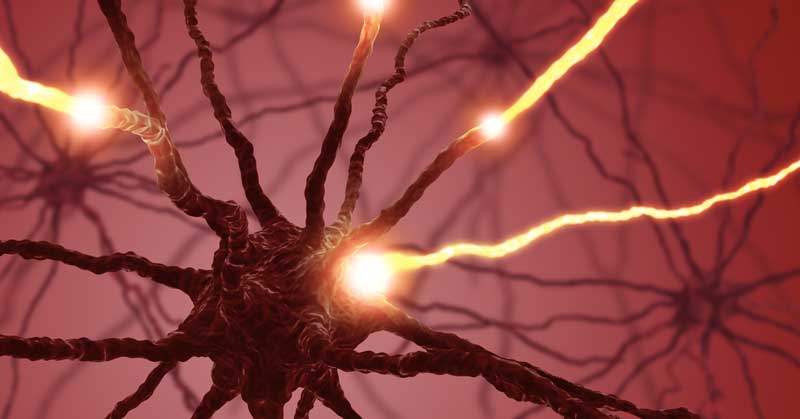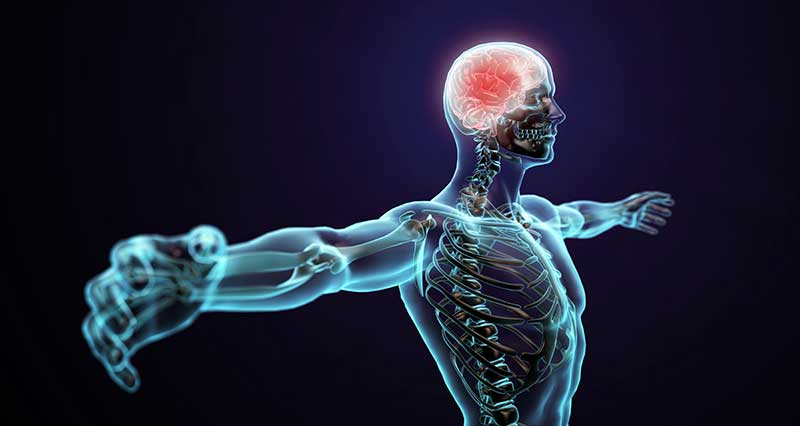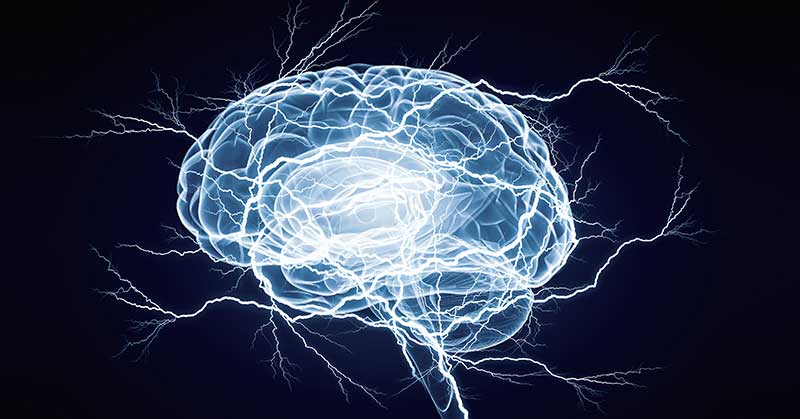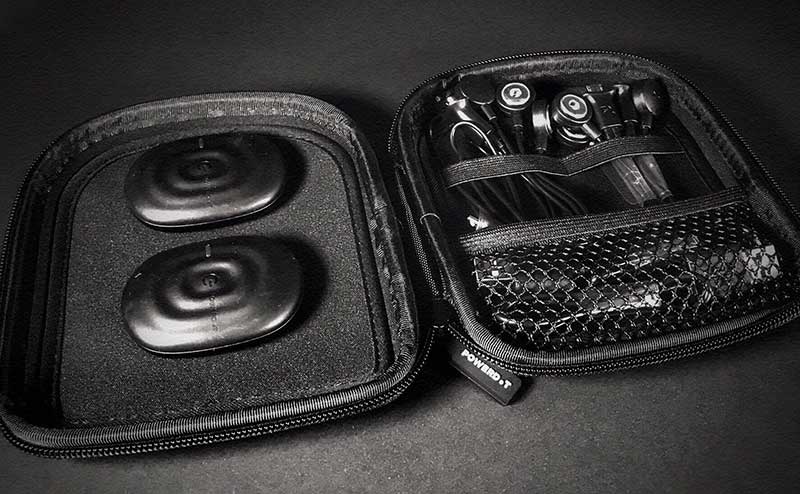[mashshare]

Electrical muscle stimulation (EMS) offers true benefits for sport performance professionals and those in the physical training and rehabilitation fields. If it were up to me, everyone would have their own EMS device to improve performance, manage fatigue and pain, enhance recovery, improve sleep, and elevate mood. This is not dissimilar to Bill Gates’ desire to have a “Computer on every desk, and in every home, running Microsoft software.” Although I’d like to think my motives are much more altruistic, I’ll leave that assessment to you after reading this article.
Research clearly shows that EMS can have positive effects on voluntary strength as well as abilities associated with improved muscle recruitment.1 It’s also a highly effective means of educating people about the adaptability and plasticity of the nervous system. I’ve been using EMS with athletes for over twenty-two years, starting with a simple machine with relatively fixed parameters. Since then, I’ve worked with a wide variety of machines and technologies as well as thousands of athletes. And I reach the same conclusions over and over again:
- Electricity is a powerful tool to manage neurological processes and monitor the efficacy of these processes.
- The practitioner’s skill heavily outweighs the sophistication of the machine.
- Individual variability can be profound, so using a cookie cutter approach is both irresponsible and ineffective.
- Human adaptability is not only the question and answer but also the problem and solution.
- The brain governs all.
Having said this, I admit that the further you go down the EMS rabbit hole, the more you unearth questions rather than answers. Hence, my EMS experience has been an education discovering the nuances, raw patterns, and trends of nervous system responses rather than developing quick and easy solutions. Before you continue reading and trying to determine how EMS can solve all your problems and make life easier, be prepared to be thrown even more off balance. Up may appear down, left may look like right, and in may be out. This is how I like it. Certainty is not a place you want to exist, as it creates a situation where you’re unprepared for day-to-day life’s variability and unpredictability. Those who yearn for certainty are most definitely destined for disappointment.
During a walk in downtown Toronto with Charlie Francis, I asked him about the certainty of specific training approaches, and he replied:
“We can’t be absolutely certain of anything. There is no certainty that there will be a tomorrow. Science cannot prove that there will be a tomorrow. We believe there will be a tomorrow, because yesterday we were on this planet and today we are still on this planet. That is our only real proof. But, we could get run over by a bus at any moment during our walk today, and there might not be a tomorrow for us. Am I certain there will be a tomorrow? Absolutely not. I’m just expecting there will be a tomorrow, based on my prior experience.”
Needless to say, for the remainder of our walk I was hyper-aware of my surroundings and looking for large, speeding vehicles. Charlie’s way of looking at problems and his wariness of predictions has stuck with me in every aspect of my life, including the application of EMS.
In this article, I am not trying to sell anything or promote any particular approach to using EMS. I’m simply trying to communicate the reasons why I believe it’s a highly effective means of educating people about the adaptability and plasticity of the nervous system. When I introduce people to the concept of electrical stimulation, people immediately request “how to” solutions. “Where do I put the pads? How high do I turn up the intensity of the unit? How frequently should I use this program? How come it doesn’t come with a comprehensive instruction manual?” Aside from some very basic instructions on how to turn on the unit and some rough guidelines for pad placement, I tell them first and foremost to experiment with it.
The great thing about most EMS units is that you can’t damage yourself. Certainly you can cause pain and extreme discomfort, particularly if you get creative. While a barbell or kettlebell can do extreme amounts of damage to a person or facility if misused, EMS is one of the safer means of training, assuming you aren’t using it in the bathtub. As many of you have already found, trial and error is one of the most effective means of learning as long as you learn from your errors and make the necessary adjustments moving forward.
Referring back to my five conclusions regarding EMS technology, we can discuss the true benefits of electrical stimulation for the sport performance professional and others in the physical training and rehabilitation fields.
Electrical Stimulation for Monitoring and Managing Neurological Function
EMS’s biggest impact on my work has been in performance sport and return-to-competition scenarios where it provides information for assessing the status of an athlete’s peripheral and central nervous systems. Many studies have reported that electrical impedance is a byproduct of muscle damage and injury. The presence of edema reduces resistance to current flow, with healthy tissue offering more resistance. Recent studies also have determined that EMS can measure the severity of injury through localized bioimpedance measurement (L-BIA) and detection of physical gaps in muscle tissue, supporting the use of ultrasound and MRI.2
After reading the research, I initially thought that electrical stimulation detected structural disruptions in soft tissue. The more I worked with EMS in post-injury cases, however, the more I found that what I thought was impedance instead was a reflection of the nervous system’s tendency to inhibit function as a means of self-preservation. Pain alerts the brain that there’s potential for further damage to the body, and the brain shuts down specific motor units that could potentially lead to greater injury. The irony is that the brain’s natural tendency to inhibit function actually results in further impaired function and perhaps even a greater system failure concerning the body and brain. As we know, dysfunction and weakness in one area often lead to over-use issues and eventual failure in another area.

Case Study
EMS can confirm the nervous system’s inhibitory tendency during conditions of acute and chronic injury. I worked with an Olympic champion weightlifter who had acute and chronic knee pain that created an inhibitory response in her vastus medialis and other muscles in the quadriceps group. Greater inhibition of the nervous system created significant unbalanced stresses to the knee joint and significantly more pain. The chronic pain perpetuated the problem for one year before she consulted me–and we began using electrical stimulation.
The EMS device confirmed that significantly more current–three times that of the healthy VMO–was required to elicit a maximal contraction in the quadriceps. There was no scar tissue in the VMO, as the point of injury was the knee joint. Several MRI evaluations detected no muscular or connective tissue damage. However, the noxious stimulus created in the knee joint was essentially muting innervation to the quadriceps muscle group in a futile attempt to rectify the situation. In many ways, this response by the brain could be likened to an undesirable autoimmune response that wreaks havoc on the body where a genuine desire to help leads to unintended consequences.
EMS saved the day for this weightlifter by diagnosing the issue and ultimately recalibrating the brain to allow full recruitment in the quadriceps muscles over a period of four to six weeks. We integrated voluntary strength work with EMS to allow for a smooth transition to full function throughout the injured limb and the elimination of the pain pathway. While others were looking for obvious “hardware” problems, EMS helped to diagnose and remedy the “software” issues experienced by this athlete.
EMS of the vastus medialis can be a gateway into the status of the knee joint and hamstring. Share on XI’m convinced that regular use of an EMS device can provide insight into the status of the athlete, particularly if we’re able to record the parameters of every session. In particular, diagnostic stimulation of the vastus medialis appears to be a gateway into the status of the knee joint and the hamstring, if not other aspects of the central and peripheral nervous systems. This observation is supported by the experiences of Italian researcher and performance coach, Giuseppe Gueli, who’s been using electrical stimulation technology with some of the top soccer and ice hockey players in the world for the last twenty years with data from thousands of high performing subjects.
The Practitioner’s Skill Outweighs the Machine’s Sophistication
This shouldn’t be a surprise to anyone who uses tools effectively. I remember attending a fabulous workshop in 1993 conducted by Ted Wong, one of Bruce Lee’s dedicated students. He was the only student of Bruce Lee’s who was taught Jeet Kun Do from scratch with no previous martial arts experience. At the time of the workshop, Ted Wong was in his late fifties, weighing about 135lbs. I was amazed when a young strapping athlete who weighed about 280lbs could not take him down.
When asked about Bruce Lee’s proficiency with knives and nunchucks, Ted Wong replied, “Bruce was exceptional with everything. He could grab any household item and turn it into a deadly weapon. I remember one time when he grabbed a candlestick in his living room and was flinging it around like he was born to do it. Then, the candlestick flew out of his hand, and it almost took one guy’s head off!” There’s nothing like a firsthand Bruce Lee story to drive a point home.
My experience with EMS is no different. In my early work, I was always looking to purchase bigger and better devices to provide more profound results. As I acquired more expensive devices, I found that they didn’t deliver proportionately better results. Similar to my other training experiences, the more I focused on perfecting basic parameters such as timing, frequency, volume, and intensity of work, the more thorough and sustainable my results were. My experience with training athletes for sprinting speed was very similar. The more fixated we were on fancy shoes, supplements, training facilities, and resistance devices, the more the training went sideways. And the results were unsatisfying.
Effective electrical stimulation needs to be based on foundational principles that accumulate desirable outcomes on a consistent basis. If the athlete is not improving, something has to change. Making appropriate adjustments on the fly is critical, but it takes keen observational skills and an idea of how to optimally manipulate the protocols to yield positive responses. This is not a skill set that can be imparted in a book or video. It has to be honed over time through practice and more practice. I can point you in the direction, but you must find your own specific path. We must cultivate skills and intuition before accumulating tools and roadmaps.
Individual Variability Can be Extreme
The great thing about EMS is that the device is consistent and predictable. If you dial in 40 Hz as your frequency and 50 milliamps as your current intensity over a duration of 20 minutes, you can be pretty sure that the device will operate under those parameters (assuming you purchased the device from a reputable company). However, the responses that you observe from different athletes may be highly variable. In fact, it’s been suggested that the muscle adaptations induced by training with electrical stimulation could very well be more variable than those induced by voluntary training modalities.3

It’s important to recognize that not all EMS subjects are created equal. Responses can vary significantly depending on numerous factors, including:
- Muscle fiber composition. Research has confirmed that stimulation frequencies must be adjusted to elicit the most profound responses in individuals with a predominant muscle fiber profile. Athletes with a higher proportion of fast-twitch (Type 2) muscle fibers will require higher stimulation frequencies (70 to 100 Hz) to elicit a strong contraction for strength, power, and speed improvements using conventional EMS technology. Athletes who are slow-twitch (Type 1) dominant will respond more favorably to lower stimulation frequencies (30 to 50 Hz) to develop muscular endurance qualities.4
It’s also important that different muscle groups have different composition profiles. Hence, stimulation frequencies must be adjusted based on the muscles groups you’re targeting. Hamstrings and the rectus femoris muscles tend to have a higher proportion of Type 2 fibers while erector spinae, deltoid, and soleus muscles tend to be slow-twitch oriented. EMS frequencies should reflect these differences during application. Also recognize that all muscles have a combination of fiber types that we must address through appropriate proportions of work.
- Athlete preparedness. Individuals who are in better overall physical shape will respond more profoundly to electrical stimulation than athletes who are poorly conditioned. Typically athletes who are healthy and in good physical condition will require lower levels of current to elicit positive responses. Consider this when implementing electrical stimulation sessions among a variety of athletes. Just because one athlete can tolerate a very high current intensity doesn’t mean that you apply the same current to another athlete. The athlete who’s in better shape may require significantly less current, and driving up the intensity to an extremely uncomfortable level may make the athlete less likely to continue with the protocols.
- Athlete readiness and fatigue. Research has shown that athletes who are fatigued will require higher levels of EMS current to elicit a strong muscle contraction. Thus, it’s very useful in monitoring athlete fatigue levels over time.5 We can argue that the brain intentionally won’t allow a muscle to be recruited if the athlete is not properly recovered to engage in vigorous exercise again. If an exogenous power supply is having difficulty recruiting a muscle group, then it leads to reason that an athlete may not be ready to participate in training or competition and that further participation may lead to muscle failure and a potentially devastating injury. This underscores the importance of maintaining ongoing records of previous sessions to establish baselines that you can compare over time. Also, while using EMS to identify fatigue, it can also enhance recovery from intensive training, particularly during sleep and travel.6
- Previous injury or trauma. When an athlete incurred a previous injury, we often need to increase stimulation intensities to achieve an adequate muscular contraction. This could be a short-term adjustment, or it may persist indefinitely depending on the severity of the previous injury. In some cases, the stimulation frequency may also need adjusting. Fast-twitch and slow-twitch muscles can atrophy at different rates, and we can often overlook slow-twitch recruitment in the desire to target the large motor units. Depending on the injury’s nature and location, we may need to apply different frequencies over time for a successful outcome.
- Chronic pain. Individuals with chronic pain may require a different approach. In my experience, chronic pain sufferers can tolerate extremely high intensities of electrical stimulation in the areas of the body where they feel pain. Lower back pain sufferers can often max out a machine because they’re so accustomed to the severe pain signals emanating from their back. In these cases, I’ve had more success targeting sites away from their chronic pain locations, where stimulation intensities are much lower and are felt much more profoundly, to create an adaptive response. The jury is still out on how EMS truly impacts chronic pain as it relates to the nervous system, and there are many theories behind the mechanism, whether inhibitory or excitatory.7
- Personality traits. In my experience, athletes who are considered “high strung” or observed as “anxious” required much lower current intensities to elicit a profound response. However, these athletes also responded much more profoundly to recovery-based protocols that involved lower frequency pulsing. In many ways, the athletes were over-responders to EMS, with a relatively low stimulation intensity required to provide a positive effect.
- Current medications. Athletes who take certain prescription medications may experience atypical results with EMS. It’s not uncommon for medications to have an impact on the efficacy of EMS. Several athletes who reported taking antidepressant medication could tolerate much higher levels than those who were not taking these medications. Take care to address these cases individually. Asking athletes about their medical history and current prescriptions could be extremely useful in ensuring a proper treatment approach.
The drug naloxone, used to reverse the effects of opioids, particularly in cases of overdose, works by reversing the depression of the central nervous system caused by opioid compounds. When naloxone is applied intravenously, it results in a total reversal of electrical stimulation’s pain-relieving effects on the nervous system.8 Thus, nervous system activation or suppression via pharmaceuticals can have significant effects on the benefits of electrical stimulation and must be considered.
Sometime it’s not advisable to increase the current’s intensity to the athlete’s maximum tolerance, particularly in the initial sessions. An iterative approach of choosing a relatively high intensity for the first few sessions allows you to assess the impact on the athlete the next day without creating undue soreness or discomfort that could negatively impact the athlete’s perception of the technology.
- Occupation. While this factor may not impact athletes, I find it interesting that the individuals most fearful of using EMS were those who were most commonly exposed to electricity in their occupations. Electricians and electrical engineers expressed the most apprehension about having electricity introduced into their bodies, and for good reason. The average person’s perception of electricity is that it’s dangerous and that feeling an electric shock is a negative experience. While we do not want to curb an individual’s natural fear of electricity, we can educate them about the specific parameters of EMS technology that allow us to use it for performance and therapeutic purposes.
Human Adaptability: Both the Question and the Answer; the Problem and the Solution
By using EMS, I’ve obtained a very good education in understanding human beings’ adaptability over time. My work with individuals experiencing long-term chronic pain has changed how I approach my work with athletes. EMS provides a very precise method to facilitate changes in the nervous system via current intensity that’s far and above the influence of other parameters.
With EMS, we can teach athletes to fire muscles more efficiently, relax muscles and minimize pain. Share on XNeuroplasticity is the brain’s ability to reorganize itself by forming new neurological connections and pathways. With EMS, you can teach an athlete to fire muscles more efficiently, relax muscles and decrease tone, and minimize pain. These functions are the product of neuroplasticity and can be developed and sustained with long-term EMS use, as well as many other techniques, to impact afferent pathways and influence sensory and motor cortices.9
I’ve had exceptional results using EMS not only for improving performance but also managing injury. I can very safely introduce a very powerful stimulus into the body and nervous system while keeping track of the intensities achieved from session to session. I can also rotate the stimulus around the body to keep the nervous system adaptive, taking advantage of the neuroplastic benefits of EMS. In adult humans, rapid plastic changes in the motor and sensory cortices has been induced by alteration of afferent input.
By keeping the nervous system off balance and adaptive (plastic), we can advance the athlete much more quickly and profoundly without having to change many other elements in their training program. In this way, electrical stimulation can amplify the signal qualities of other training elements.
Electrical stimulation can amplify the signal qualities of other training elements. Share on XThe process becomes even more complex upon understanding that the brain can reorganize itself to resurrect, retain, and amplify past signals and tendencies. As Dr. Norman Doidge points out, “chronic pain is basically neuroplasticity gone wild.”10 The nervous system becomes more efficient at processing pain. An individual’s neuroplastic abilities can amplify and adapt the body to maintain chronic pain sensations as if the body is sounding an alarm about an injury that may no longer exist. When dealing with chronic pain, EMS must be profoundly intense but also extremely dynamic in how the stimulus is rotated and how other qualities, such as movement, are introduced in the treatment approach. The afferent properties of electrical stimulation and exercise, particularly in combination, can help re-pattern the brain to reflect a state of function, health, and wellness that does not require the production of chronic pain.
EMS can help re-pattern the brain to avoid the production of chronic pain. Share on XThe Brain Governs All
It’s important to know that your brain regulates everything that happens in your body, regardless of your beliefs regarding specificity of exercises and muscles. As soon as you begin to understand these neurology and physiology facts, it becomes easier to organize your thoughts around training and rehabilitation.
When I first started working with EMS, I was overly concerned with pad placement and precisely targeting specific areas of the body. While pad placement is important, I must stress that it’s not always obvious. For injury and pain management, working away from the symptomatic area has always yielded more sustainable and complete results. In situations where I attempted to improve excitability or readiness, working away from obvious locations has always produced enhanced results.
Stimulating quadriceps always improved hamstring performance. Targeting hip flexors resulted in improved posterior chain performance and reduced lower back pain. Stimulating the upper body has been extremely effective in preparing the lower body, and vice versa. Using EMS to produce powerful muscular contractions has ultimately resulted in a muscle relaxation effect and a sense of recovery. Most conventional recovery and loosening protocols involve lower intensity pulsing actions, and rehabilitation approaches have been overly cautious, leading to further down-regulation and disuse both centrally and peripherally.

While these responses may not make intuitive sense at first glance, when we begin to examine these scenarios from the brain’s potential responses, things begin to make more sense. Applying a strong stimulus in one area of the body tends to produce adaptive and compensatory responses throughout the body, particularly in the short term.
We have the ability to take advantage of these adaptive responses within specific windows of opportunity. In my opinion, EMS should always be followed by voluntary work to solidify new pathways created by these adaptive windows. For strength, power, and speed development, use of profound EMS on the hip flexors should be followed by dynamic hip extension work. Active lengthening of the hamstrings, whether by sprinting or kicking, could follow electrical stimulation of the quadriceps.
Individuals experiencing chronic pain have typically responded better when we provide intense stimulation away from the symptomatic areas. Although these approaches may not make sense to the individual receiving the treatment, their brain will recognize the opportunity for an efficient reorganization process and a more effective redistribution of organism energy.
Practical Tips
Here are some tips to get you started on your EMS journey:
- Documentation is critical. Take notes after every session and record all parameters applied (frequency, intensity, duration, work-rest ratios, etc.) and the observed and reported responses. This type of data collection is critical to compare case studies and determine the best approach for future cases. It will also remind you that there’s never a one-size-fits-all solution.
- Using electrical stimulation should rarely be a static experience. Incorporating different positions, joint angles, and movements can be more beneficial in providing a variation in afferent messaging for the brain. While my initial forays into electrical stimulation involved lying or seated positions–likely thrust upon me by the physical therapy community’s passive approach–I’ve achieved my most recent successes with protocols involving standing and moving, sometimes under high velocity or high load conditions. When athletes cannot move, for example after major surgery or injury, using EMS with immobilization is indicated. The goal, however, is to always push toward activity and movement.
- Exercise caution in an aggressive manner. When it comes to electrical stimulation–or simply training, for that matter–there’s a fine line between creating a profound response and torturing someone. There is no doubt that applying a high-intensity stimulus can yield exceptional results. However, balancing the highs with the lows is critical for both performance and rehabilitation success. As in training, high-intensity work must be followed by larger periods of recovery and measured doses of volume. In my experience, EMS microdosing has always produced greater effects than longer sessions of moderate intensity. The acute nature of high-intensity EMS appears to break up the malaise and stagnation experienced in conventional training, as well as in life. It’s advisable, though, to develop a progression of work that prepares individuals for the “shock” of electrical stimulation without obliterating their enthusiasm for the technology.

Concluding Remarks
When people ask me what brand of electrical stimulation device they should purchase when working with athletes, I’m pretty unbiased. Although I’ve worked closely with Globus products–primarily due to the flexibility of the platform upon which to build new protocols–I suggest people work within their budget first and foremost to gain competence and confidence. As I mentioned earlier, I’ve worked with dozens of different devices over twenty-two years, and I benefitted from all of them.
Having an EMS unit gives you a chance to learn how electricity interacts with your body and brain, and how different frequencies and intensities elicit different responses. In many ways, using an EMS device is very much like learning to use a camera. You’re much better off spending less money in the beginning and learning the basics through research and trial and error before spending a large amount of money. I’ve always maintained that using electrical stimulation helps us to better understand how to train or rehabilitate an athlete. I’m now more adamant about this point. My recent experiences working with individuals who have chronic pain reinforce this assertion. Learning is best facilitated by doing, observing, reflecting, and communicating on the fly.
After all is said and done, I’m relatively confident that the most effective application of EMS will closely mirror the philosophical approach that one uses in training athletes through conventional means. In the long run, those who truly understand that the goal of training is to create windows of opportunity for the organism to adapt and move forward in a manner that produces the most beneficial and applicable results will always tend to be more successful. In many ways, we need to think about specificity as it relates to the brain and central nervous system responses, as opposed to obsessing about peripheral applications. You will only truly understand this approach once you’ve jumped into the deep end and immersed yourself in the world of electrical stimulation. I invite you to start a refreshingly new era of training, recovery, and rehabilitation.
Since you’re here…
…we have a small favor to ask. More people are reading SimpliFaster than ever, and each week we bring you compelling content from coaches, sport scientists, and physiotherapists who are devoted to building better athletes. Please take a moment to share the articles on social media, engage the authors with questions and comments below, and link to articles when appropriate if you have a blog or participate on forums of related topics. — SF
[mashshare]
References
- Filipovic, A., Kleinoder, H., Dormann, U., and J. Mester. Electrostimulation – A Systematic Review of the Effects of Different Electromyostimulation Methods on Selected Strength Parameters in Trained and Elite Athletes. The Journal of Strength and Conditioning Research. 26:9 (2012) 2600-2614.
- Nescolarde, L., Yanguas, J., Terricabras, J., Lukaski, H., Alomar, X., Rosell, X., and G. Rodas. Detection of Muscle Gap by L-BIA in Muscle Injuries: Clinical Prognosis. Physiological Measurement. 38 (2017) L1-L9.
- Minetto, M.A., Botter, A., Bottinelli, O., Miotti, D., Bottinelli, R., and G. D’Antona. Variability in Muscle Adaptation to Electrical Stimulation. International Journal of Sports Medicine. 34 (2013) 544-553.
- Behringer, M., Grutzner, S., Montag, J., McCourt, M., Ring, M., and J. Mester. Effects of Stimulation Frequency, Amplitude, and Impulse Width on Muscle Fatigue. Muscle and Nerve. 53:4 (April 2016) 608-616.
- Del Coso, J., Hamouti, N., Estevez, E., and R. Mora-Rodriguez. Reproducibility of two electrical stimulation techniques to assess neuromuscular fatigue. European Journal of Sport Science. 11:2 (2011) 95-103.
- Taylor, T., West, D.J., Howatson, G., Jones, C., Bracken, R.M., Love, T.D., Cook, C.J., Swift, E., Baker, J.S., and L.P. Kilduff. The impact of neuromuscular electrical stimulation on recovery after intensive, muscle damaging, maximal speed training in professional team sports players. Journal of Science and Medicine in Sport. April 2014.
- Benabid, A.L., Wallace, B., Mitrofanis, J., Xia, C., Piallat, B., Fraix, V., Batir, A., Krack, P., Pollak, P., and F. Berger. Therapeutic electrical stimulation of the central nervous system. C. R. Biologies. 328:2 (2005) 177–186.
- Hosobuchi, Y., Adams, J.E., and R. Linchitz. Pain Relief by Electrical Stimulation of the Central Gray Matter in Humans and Its Reversal by Naloxone. Science. 197:4299 (1977) 183-186.
- Chipchase, L.S., Schabrun, S.M., and P.W. Hodges. Peripheral Electrical Stimulation to Induce Cortical Plasticity: A Systematic Review of Stimulus Parameters. Clinical Neurophysiology. 122:3 (2011) 456-463.
- Doidge, Norman. The Brain’s Way of Healing: Remarkable Discoveries and Recoveries from the Frontiers of Neuroplasticity. Penguin Books, New York (2015).



